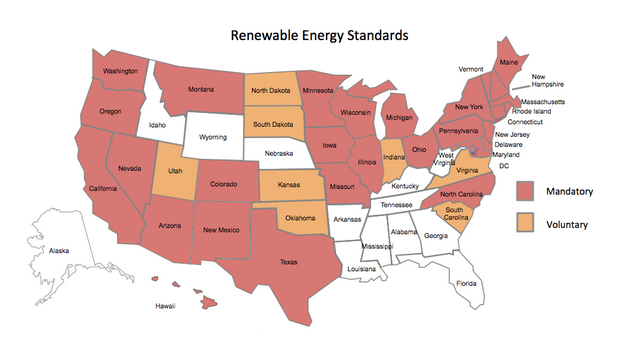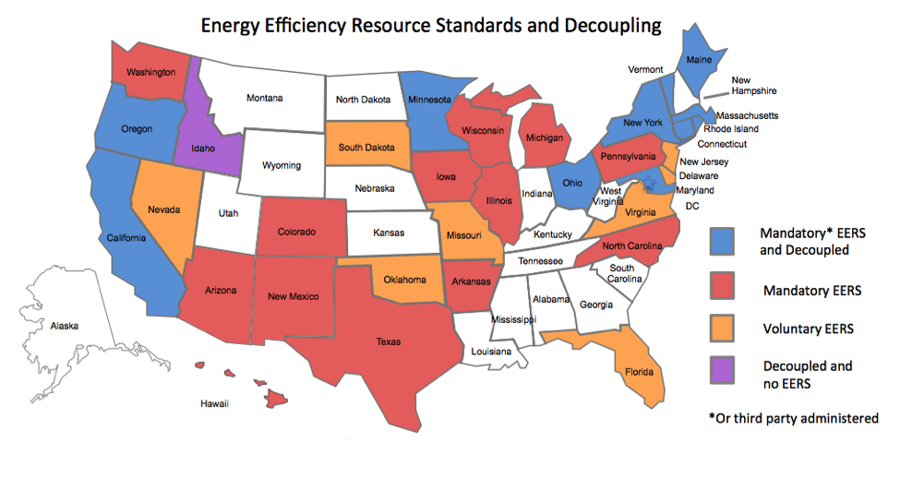Does your state have a renewable portfolio standard or an energy efficiency resource standard? Have your electric utilities had their revenue decoupled from volume of electricity sales? How do your state’s policies stack up with the rest of the country? Do you even know what these policies mean?
AEE now has everything you need to know about key state energy policies. It’s all on PowerPortal, your one-stop shop for high-value information on key energy sector participants, utility programs and energy data in each state. See this alongside other data already in the PowerPortal, including utility structures, schedules for key renewable energy and energy efficiency proceedings, time varying rates programs, and much, much more! PowerPortal is part of AEE’s PowerSuite. Sign up for a free trial here.
In the meantime, here are 10 tidbits on Renewable Portfolio Standards, Energy Efficiency Resource Standards and revenue decoupling to get you started!
A Renewable Energy Standard (RES) or its equivalent (such as a Renewable Portfolio Standard) is a regulatory mandate or goal that calls for “load serving entities” - utilities or retail suppliers - within each state to generate or procure a minimum portion of their electricity from renewable energy sources such as wind, solar, biomass, geothermal and hydropower.

Source: AEE PowerPortal
- Iowa became the first state to have an RES when, in 1983, the state enacted its Alternative Energy Law, which required the state's two largest utilities to contract for a combined 105 MW of renewable energy per year. Today Iowa procures more than 5,000 MW of capacity, far surpassing their outdated RES because it has become cost competitive (with almost 30% of their generation coming from wind alone).
- Thirty states have a mandatory RES and eight states have voluntary programs. Eight states - Wisconsin, Texas, South Dakota, Oklahoma, New York, North Dakota, Montana and Michigan - have standards that are set to expire in 2015. Some of these states may let their RES expire while others are sure to extend them, but only time will tell.
- Of the 39 states that have enacted an RES of some kind, three were created by a public utility commission order, three by a ballot initiative, and 33 by legislation.
An Energy Efficiency Resource Standard (EERS) is a regulatory mandate or goal that requires utilities within each state to meet energy savings and, sometimes, peak demand targets.

Source: AEE PowerPortal
- Texas was the first state to pass a mandatory EERS in 1999. Traditionally, the state’s EERS has been based on reducing incremental load growth. With most utilities now seeing flat or declining load growth, the new mandate has transitioned to reducing peak demand.
- 22 states have a mandatory EERS, while eight have voluntary standards, and another three - Nevada, Oklahoma, and South Dakota - can voluntarily meet a portion of their RPS with efficiency measures.
- The District of Columbia, Delaware, Vermont, Maine, and Oregon all have a voluntary EERS and they all have another thing in common: they administer their energy efficiency program through third parties. These programs are paid for through a small surcharge on a customer’s bill. By using a third party implementer, they remove the utilities’ inherent conflict of interest in promoting energy efficiency that reduces electricity sales.
Revenue decoupling is a policy where utility revenue is no longer strictly determined by the amount (volume) of energy the utility sells. It is a powerful tool when used in concert with an EERS because it removes the utility disincentive to increase sales volume. This is intended to make them indifferent to greater deployment of energy efficiency technologies.
- Revenue adjustments as a result of decoupling - to make sure utilities get sufficient revenue even if sales go down, and don’t collect too much money if sales go up - differ from state to state and utility to utility. Some make adjustments monthly, some annually and some less frequently.
- Actual revenue can differ from rate case authorized revenue as a result of many things, including: energy efficiency, conservation, economic conditions, weather and price elasticity of demand. Detractors have said that decoupling can shift risk from utilities to consumers in the form of higher rates such as the case in Maine’s first failed decoupling experience in the early 1990s.
- Fourteen states have electric utilities that are currently decoupled in some form. Seven states have a decoupling policy in place that has yet to be implemented, have suspended decoupling, or have discontinued previous pilot experiments as a result of the aforementioned risk shifting concern.
- Lost revenue adjustment mechanisms, used in Arizona and Nevada among others, are similar to, but less effective than, decoupling because they only target specific programs and they do not remove the utility incentive to increase sales volumes.
Ready to dive in and find fun facts of your own? Sign up for a free trial here and start browsing and searching PowerPortal!
